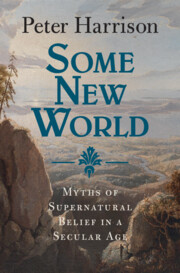171 results
Introduction
-
- Book:
- Some New World
- Published online:
- 29 March 2024
- Print publication:
- 18 April 2024, pp 1-12
-
- Chapter
- Export citation
5 - The Birth of the Supernatural
-
- Book:
- Some New World
- Published online:
- 29 March 2024
- Print publication:
- 18 April 2024, pp 218-282
-
- Chapter
- Export citation
Acknowledgements
-
- Book:
- Some New World
- Published online:
- 29 March 2024
- Print publication:
- 18 April 2024, pp vii-x
-
- Chapter
- Export citation
2 - Languages of Belief
-
- Book:
- Some New World
- Published online:
- 29 March 2024
- Print publication:
- 18 April 2024, pp 24-67
-
- Chapter
- Export citation
Bibliography
-
- Book:
- Some New World
- Published online:
- 29 March 2024
- Print publication:
- 18 April 2024, pp 381-456
-
- Chapter
- Export citation
Copyright page
-
- Book:
- Some New World
- Published online:
- 29 March 2024
- Print publication:
- 18 April 2024, pp iv-iv
-
- Chapter
- Export citation
6 - The Shape of History
-
- Book:
- Some New World
- Published online:
- 29 March 2024
- Print publication:
- 18 April 2024, pp 283-352
-
- Chapter
- Export citation
3 - Inventing Epistemology
-
- Book:
- Some New World
- Published online:
- 29 March 2024
- Print publication:
- 18 April 2024, pp 68-129
-
- Chapter
- Export citation
Contents
-
- Book:
- Some New World
- Published online:
- 29 March 2024
- Print publication:
- 18 April 2024, pp v-vi
-
- Chapter
- Export citation
Abbreviations
-
- Book:
- Some New World
- Published online:
- 29 March 2024
- Print publication:
- 18 April 2024, pp xi-xiv
-
- Chapter
- Export citation
Reviews
-
- Book:
- Some New World
- Published online:
- 29 March 2024
- Print publication:
- 18 April 2024, pp ii-ii
-
- Chapter
- Export citation
Index
-
- Book:
- Some New World
- Published online:
- 29 March 2024
- Print publication:
- 18 April 2024, pp 457-467
-
- Chapter
- Export citation
4 - The Age of Evidences
-
- Book:
- Some New World
- Published online:
- 29 March 2024
- Print publication:
- 18 April 2024, pp 130-217
-
- Chapter
- Export citation
7 - What the Greeks Saw
-
- Book:
- Some New World
- Published online:
- 29 March 2024
- Print publication:
- 18 April 2024, pp 353-380
-
- Chapter
- Export citation
1 - Hume’s Dilemma
-
- Book:
- Some New World
- Published online:
- 29 March 2024
- Print publication:
- 18 April 2024, pp 13-23
-
- Chapter
- Export citation

Some New World
- Myths of Supernatural Belief in a Secular Age
-
- Published online:
- 29 March 2024
- Print publication:
- 18 April 2024
25 In-hospital Change in Lung Ultrasound Congestion Score Predicts Heart Failure Rehospitalization and Death: Implications for Clinical Trials
- Part of
-
- Journal:
- Journal of Clinical and Translational Science / Volume 7 / Issue s1 / April 2023
- Published online by Cambridge University Press:
- 24 April 2023, p. 7
-
- Article
-
- You have access
- Open access
- Export citation
The impact of using an income supplement to meet child poverty targets: evidence from Scotland
-
- Journal:
- Journal of Social Policy , First View
- Published online by Cambridge University Press:
- 20 December 2022, pp. 1-17
-
- Article
-
- You have access
- Open access
- HTML
- Export citation
References
-
- Book:
- After Science and Religion
- Published online:
- 05 May 2022
- Print publication:
- 19 May 2022, pp 325-347
-
- Chapter
- Export citation
Part I - Modern Historians on ‘Science’ and ‘Religion’
-
- Book:
- After Science and Religion
- Published online:
- 05 May 2022
- Print publication:
- 19 May 2022, pp 13-58
-
- Chapter
- Export citation



